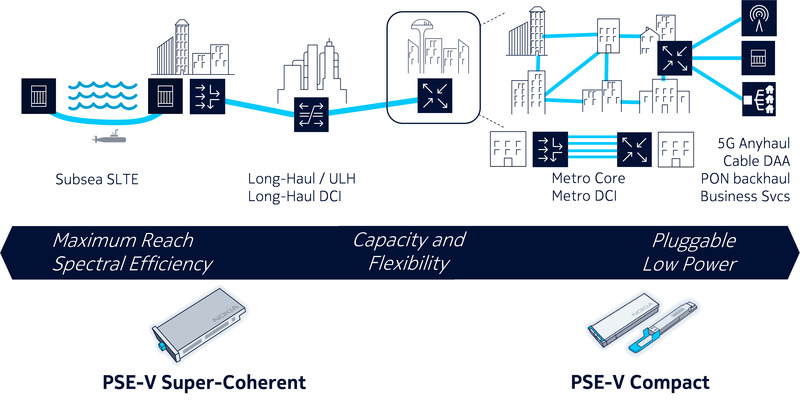Playing a major role in aggregating and transporting traffic flows over long distances is the optical transport network. Continuous advancements in optical transport technologies specifically the use of coherent optics have enabled unprecedented transmission bit-rates, increased deployment flexibility and greater optical performance, leading to a significant growth in transport capacity in tandem with the rise in data traffic.
Different networks, different needs
Optical transport networks power a wide range of applications with varying network objectives. At the far end of the spectrum are the subsea and long-haul networks spanning hundreds of kilometres with the goal of maximizing capacity-reach and spectral efficiency. Closer to the users, optical transport networks form the metro and regional core networks connecting PON backhaul, 5G Anyhaul, cable DAA and enterprises. These applications require capacity upgrades that can be executed seamlessly on top of the existing infrastructure, with minimum power requirements. Between both ends is the use of optical transport for data center interconnection (DCI) where the focus is to deliver sufficient capacity with deployment flexibility across optical transport and router platforms.
 Application-optimized coherent optical transport
Application-optimized coherent optical transport
Speed and scalability
The push for application-optimized coherent optical transport comes from a number of factors. Foremost among these is the need to scale the network modularly based on distinct capacity and reach requirements across different applications, amidst the overall growth in demand for bandwidth. The second factor revolves around the trade-off between performance and costs. Each application – from the metro core to subsea - requires different reach, speeds, latencies and have different limitations in terms of power and cost. The third factor is the rapid growth in transceiver speeds, where tightly integrated DCOs are necessary to maintain signal integrity. These factors, collectively, are addressed by application-optimized coherent optics that allow application-specific configurations, maximizing network performance while minimizing costs.
Taking coherent optics to the next level
Enabling application-optimized networking is Nokia’s 5th generation Photonic Service Engine (PSE-V) coherent optical solution. The solution comprises 2 types of digital coherent optics (DCOs) - the PSE-V Super Coherent (PSE-Vs) and the PSE-V Compact (PSE-Vc).
PSE-Vs comes into play in scenarios requiring maximum capacity-reach by delivering higher wavelengths over longer distances while bringing down the cost and power consumption per bit. PSE-Vs thus is a great fit for long-haul, subsea and regional networks, allowing data transfer rates on these links to inch closer to the Shannon limit. PSE-Vs comes in both embedded and pluggable versions. The PSE-Vs delivers 600Gb/s up to 1500 km over long-haul networks and 400Gb/s per wavelength across ultra-long-haul and subsea fiber span. It is optimized for use in 100GHz WDM channel spacings over CDC-F wavelength switched networks. PSE-Vs is available in Nokia’s 1830 PSI-M compact modular disaggregated transponder platform, the 1830 PSS integrated WDM/transponder family and the 1830 PSS-x P-OTN switches. It boasts a number of advanced features including 2nd generation probabilistic constellation shaping with continuous baud rate adjustment and high-gain/low overhead forward error correction.
 The PSE-V family of products
The PSE-V family of products
PSE-Vc DCOs on the other hand are optimized for power and performance and are packaged in industry standardized CFP2 pluggable form factor for use in routers and optical transport systems. This makes PSE-Vc an apt solution for scaling capacity needs modularly across access and metro networks as well as for data center interconnect and metro-regional applications. PSE-Vc 400G pluggable DCO modules are capable of supporting 100-400Gb/s multihaul transport for distances over 1000km. At the same time, router pluggable QSFP-DD or OSFP 400G transceivers support 400ZR+ for metro-regional DCI and 400ZR for access DCI and can be used to power core IP-optical networks.
Highly complex and challenging optical transport applications benefit from the unrivalled capacity-reach provided by PSE-Vs. Long haul and subsea networks benefit from its spectral efficiency, which leads to lower overheads and overall improved network economics. By allowing seamless capacity upgrades, PSE-Vs lowers the total cost of ownership (TCO) of optical transport networks. Similarly, PSE-Vc cuts down on power consumption by adjusting capacity to usage needs across metro networks and DCI. The use of pluggable DCOs also allows modularity, leading to cost effective upgrades. Additionally, sensitive and low-latency user applications delivered from the edge as in the case of 5G benefit from superior traffic performance fuelled by PSE-Vc.
Early success
Real-world testing and deployment of application-optimized coherent optics have begun taking shape. In a live trial with Italy’s TIM in May this year, Nokia showcased successful transmission of 600G over a 1008k long-haul network using PSE-V. The trial saw the use of PSE-Vs in the 100GHz WDM channel to deliver spectral efficiency of 6bits/sec/Hz over a live network enabling TIM to deliver 400 Gigabit Ethernet (400GE) over its terrestrial backbone network. The demonstration involves PSE-Vs which was deployed in Nokia’s 1830 PSI-M compact modular disaggregated transport system on Nokia’s CDC-F ROADM architecture.
The demonstration follows an earlier 600G field trial using Nokia PSE-Vs, conducted jointly by Nokia and Global Connect, a leading provider of fiber-based data communications and data center services in Northern Europe. The demonstration which used PSE-Vs super coherent optics embedded in Nokia’s 1830 PSI-M optical transport system saw successful 600G transmission over Global Connect Group’s GO-COLOR terrestrial network. The demonstration validates PSE-Vs in powering spectrally-efficient network capacity upgrades in real-world scenarios, enabling Global Connect’s ROADM network to deliver, flexibly, high-bandwidth data center interconnect services across its long-haul backbone network.
The new level of efficiency and scalability enabled by Nokia PSE-Vs is expected to accelerate operator business outcomes. In January, WINDTRE, an Italian operator with over 30 million customers, deployed a DWDM solution powered by Nokia PSE-Vsto support programmable line rates of up to 600G over its optical backbone network. With features such as redundant nodes in a wave router configuration, a mesh structure and GMPLS-based restoration, the new backbone will boast higher routing flexibility and increased network reliability. Benoit Hanssen, CTO of WINDTRE said, “Nokia’s solution based on industry-leading coherent technology will help us provide next generation broadband services to both consumer and business customers in the most efficient way. It will also enable us to grow our subscriber base and provide best-in-class experience to WINDTRE’s existing customers."
Perfecting the balancing act
Nokia PSE-V is bringing network agility to the next level. By balancing performance and costs in tightly integrated modules, application-optimized Nokia PSE-V coherent optics allow operators to shape transport capacity and performance based on their exact needs, paving way for networks that are truly flexible, responsive and scalable.
For more information on Nokia PSE-V, please visit:
- Nokia PSE-V Interactive eBook
- Nokia PSE-V Solution page
- Nokia PSE-V Whitepaper: Nokia PSE-V Coherent Solutions Beyond the Limit






















